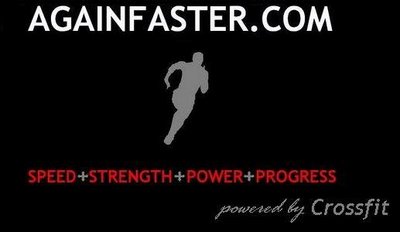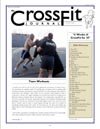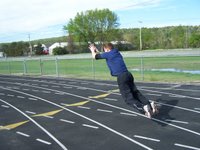First Aid

I’ve been unsuccessfully trying to master the Olympic lifts for the last month.
My total and utter lack of God-given coordination, combined with the fact that the lifts are technically demanding, has left me donkey-kicking, under-extending, and hitching my way through rep after rep.
Several people have watched me flail at weightlifting glory. Each and every one, regardless of coaching experience, says the same thing:
“You stop in the middle.”
This vague assertion refers to the transition between the first and second pulls, where the barbell is lifted above the knee and the hip scoops under it in preparation for the ensuing jump and land sequence.
Given this feedback, I always ask, “How do I fix it?”
Unfortunately, the answer is either speed up, slow down, shrug harder, jump higher, get new shoes, or give up, depending on the identity of the critic-of-the-moment. In other words, nobody in my immediate vicinity has the expertise to know what’s wrong with my shitty pull.
Luckily, someone in Australia does.
Last Friday, I was reading through the Performance Menu forum when I came across an aptly named thread called “Pulling Mechanics Article”. Within this diatribe, Greg Everett linked an article by Leo Isaac of the Queensland Weightlifting Association, entitled “Acceleration and Deceleration Phases in the Pull”.
I printed it out. It had a graph, a section on “system velocity”, and looked like it would put me to sleep if I read it. I took one look and stuffed it in my briefcase. I was eager to get to the gym and practice my ugly snatch, and I didn’t have time to be bored.
An entire weekend and several hours of coaching later, I was on the subway, finally reading through Mr. Isaac’s four-page dissertation on the pull.
His point was simple: Athletes are told to pull hard off the floor, but the transition phase scrubs most of the resulting velocity off the bar. The bar only reaches maximum velocity on the second pull, long after the transition. Therefore, the best way to lift is to accelerate constantly from the ground through the second pull, minimizing any loss of velocity during the transition phase.
He notes that the best lifters do this naturally. I noted that I do not. My transition is like a sports car hitting a jersey barrier at 120 miles an hour. Everything stops, and then the wheels come off.
Thankfully, Mr. Isaac goes on to describe how one would actually fix this problem. He posits that the dramatic pause during the transition phase is caused by an overly-horizontal back position, leading to a prolonged scoop as the back travels to vertical for the subsequent jump.
He nailed it. You could hold a tea party on my back in the starting position, and empires have crumbled in the time it takes me to get vertical. I smiled maniacally at the bum sitting across the aisle from me, thrilled to have a solution within my grasp.
The bum smiled back.
I went to the gym, grabbed a PVC pipe, and spent a half-hour working on my transition. I started with my back as vertical as possible without my shoulders being behind the bar, and I pulled again and again.
The hitch was gone, and I yelled for Neal to come check it out. He looked at my pull, paused thoughtfully, and said:
“You’re still donkey-kicking.”
Go faster!
Picture of Shane Hamman courtesy of www.gamesinfo.com.au. For a cool look at system velocity and some really strong women, have a look at this video from Tracey Fober and Iron Maven.

I’ve been unsuccessfully trying to master the Olympic lifts for the last month.
My total and utter lack of God-given coordination, combined with the fact that the lifts are technically demanding, has left me donkey-kicking, under-extending, and hitching my way through rep after rep.
Several people have watched me flail at weightlifting glory. Each and every one, regardless of coaching experience, says the same thing:
“You stop in the middle.”
This vague assertion refers to the transition between the first and second pulls, where the barbell is lifted above the knee and the hip scoops under it in preparation for the ensuing jump and land sequence.
Given this feedback, I always ask, “How do I fix it?”
Unfortunately, the answer is either speed up, slow down, shrug harder, jump higher, get new shoes, or give up, depending on the identity of the critic-of-the-moment. In other words, nobody in my immediate vicinity has the expertise to know what’s wrong with my shitty pull.
Luckily, someone in Australia does.
Last Friday, I was reading through the Performance Menu forum when I came across an aptly named thread called “Pulling Mechanics Article”. Within this diatribe, Greg Everett linked an article by Leo Isaac of the Queensland Weightlifting Association, entitled “Acceleration and Deceleration Phases in the Pull”.
I printed it out. It had a graph, a section on “system velocity”, and looked like it would put me to sleep if I read it. I took one look and stuffed it in my briefcase. I was eager to get to the gym and practice my ugly snatch, and I didn’t have time to be bored.
An entire weekend and several hours of coaching later, I was on the subway, finally reading through Mr. Isaac’s four-page dissertation on the pull.
His point was simple: Athletes are told to pull hard off the floor, but the transition phase scrubs most of the resulting velocity off the bar. The bar only reaches maximum velocity on the second pull, long after the transition. Therefore, the best way to lift is to accelerate constantly from the ground through the second pull, minimizing any loss of velocity during the transition phase.
He notes that the best lifters do this naturally. I noted that I do not. My transition is like a sports car hitting a jersey barrier at 120 miles an hour. Everything stops, and then the wheels come off.
Thankfully, Mr. Isaac goes on to describe how one would actually fix this problem. He posits that the dramatic pause during the transition phase is caused by an overly-horizontal back position, leading to a prolonged scoop as the back travels to vertical for the subsequent jump.
He nailed it. You could hold a tea party on my back in the starting position, and empires have crumbled in the time it takes me to get vertical. I smiled maniacally at the bum sitting across the aisle from me, thrilled to have a solution within my grasp.
The bum smiled back.
I went to the gym, grabbed a PVC pipe, and spent a half-hour working on my transition. I started with my back as vertical as possible without my shoulders being behind the bar, and I pulled again and again.
The hitch was gone, and I yelled for Neal to come check it out. He looked at my pull, paused thoughtfully, and said:
“You’re still donkey-kicking.”
Go faster!
Picture of Shane Hamman courtesy of www.gamesinfo.com.au. For a cool look at system velocity and some really strong women, have a look at this video from Tracey Fober and Iron Maven.




















0 Comments:
Post a Comment
<< Home